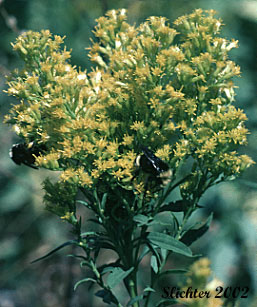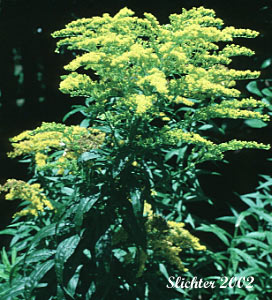

 The
photo at right shows meadow goldenrod from near Gresham, Oregon, July 1993.
The
photo at right shows meadow goldenrod from near Gresham, Oregon, July 1993.
Meadow goldenrod is an attractive perennial wildflower with erect, stout stems arising from 40-200 cm high. The herbage varies from densely short-haired throughout the plant to minutely pubescent on the upper half of the stem. The leaves are numerous and mostly on the stems. Any basal leaves are small and soon deciduous, as are the lower stem leaves. The upper leaves are only slightly reduced in size if at all. Individual leaves range form lance-linear to rather narrowly lance-elliptic in shape, tapering gradually to the sessile base. The blades have three main veins or nerves and measure from 5-15 cm long and 5-22 mm wide. The margins of the leaves range from entire to toothed.
The inflorescence is terminal, with many panicles arching up and outward from the stem, the tips recurved downward. The inflorescence itself measures from 15-30 cm long and 10-20 cm wide. The involucres of individual flowers range from 2-5 mm high with with thin bracts which taper to very slender tips. The yellow rays number from 10-17 and surround a narrow yellow disk. The rays measure from 1-3 mm long.
Meadow goldenrod blooms over a fairly long period during late summer and early fall and is easily grown in natural gardens. Insects like it as a nectar source. It does spread fairly easily via under ground rhizomes.
Meadow goldenrod may be found in damp ground both on open ground as well as in open forests or forest openings. It can also be somewhat weed-like (the creeping rhizomes make it hard to control) and may be found along roadsides and in ditches.
Meadow goldenrod may be found from Alaska south across southern Canada and across much of the United States.
In the Columbia River Gorge it is found between the elevations of 0'-4000' across the length of the Gorge.